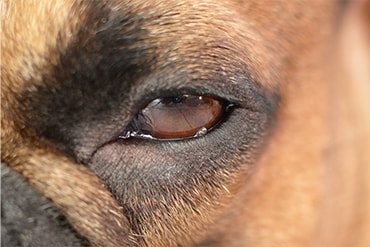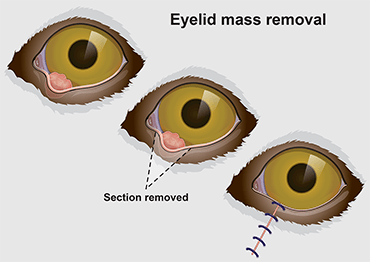Eyelid growths/lumps on dogs eyelids
Overview
- Eyelid growths are common in dogs but fortunately, most of them are benign (non-cancerous).
- Cancerous or not, if your dog has a growth on their eyelid, it’s best that it’s removed before it gets bigger and more difficult to treat.
- Small, non-cancerous eyelid growths can usually be removed easily with a small section of the eyelid, but cancerous growths can sometimes require major surgery and other treatments.
- Get all new or changing lumps checked by your vet.
General information
Finding a lump on your dog can be worrying, but fortunately, around 75% of eyelid lumps in dogs are benign (non-cancerous). However, in most circumstances eyelid lumps are best removed because if they grow large, they tend to cause irritation, rub the surface of the eye, and become much more difficult to treat. Eyelid growths are most common in older dogs, but there are certain types (such as warts and histiocytomas) that can affect young dogs.
As well as a visible lump, eyelid growths often cause other symptoms such as weeping, pain, itchiness, redness and inflammation.

Types
A few different things can cause a lump on an eyelid:
A blocked gland
If one of the tiny glands in the eyelids becomes blocked, infected, or inflamed, it will swell and look like a small growth.
A non-cancerous growh
Some of the most common benign (non-cancerous) eyelid tumours that can affect dogs include:
- Warts - warts on the eyelid are hairless, bumpy and usually the same colour as the eyelid (for example pink from a pink eyelid, and black from a black eyelid). In young dogs (less than three years old), they tend to be caused by a virus (‘papilloma virus’), and often resolve without treatment. In older dogs, they tend to develop with no obvious cause, and grow slowly over time. Removal of an eyelid wart in an older dog is often sensible if it grows quickly, rubs the front of the eye, bleeds, catches, or starts to cause any other problems.
- Adenomas - these are very common eyelid tumours in dogs. They are slow growing, often dark in colour, bleed easily and crust over with scabs.
- Histiocytomas - these fast growing, red, angry looking tumours mostly affect dogs under two years old. Most histiocytomas shrink and disappear without treatment (over a few weeks to months), but occasionally need removing if they are slow to improve.
- Melanoma - these black/brown tumours are mostly benign, but occasionally can be malignant (cancerous).
Cancerous eyelid tumours
Cancerous tumours of the eyelid are usually fast-growing, red, and angry looking. They tend to ulcerate, scab and bleed very easily. Fortunately, cancerous tumours of the eyelids are rare in dogs.
Treatment
Cancerous or not, most eyelid growths are best removed. This is because they have the potential to grow, rub the surface of the eye, cause problems, and become much harder to treat. Your vet may advise against removing an eyelid lump if it’s unlikely to cause a problem in your dog’s lifetime, your dog has a high risk under anaesthetic, or if they have been diagnosed with a histiocytoma (which is likely to resolve by itself).
Non-cancerous
Non-cancerous eyelid growths can usually be removed by taking a V-shaped section from the eyelid (see image above). This means that the wound your dog returns home can look much larger than the lump itself. Fortunately, they tend to heal very quickly. After surgery, your dog may have a slightly tighter eyelid (because of the section removed), however, it will stretch over time and return to a normal shape and size. If your dog’s lump is very large, surgery is likely to be much more complicated and they may need to visit a specialist eye vet.
Cancerous
If your dog has a cancerous lump on their eyelid, they may need a significant amount of skin removed from around it, and possibly other treatments such as chemotherapy. Some cancerous eyelid growths require so much tissue to be removed that enucleation (removal of an eye) is the best option.
Blocked glands
If your dog has a blocked, inflamed or infected gland in their eyelid, they may be given anti-inflammatories, and if necessary, antibiotics. As well as medications, your vet may ask you to hold warm compresses against your dog’s eye to help draw out pus and clear any blockage. If this process isn’t successful, you vet may decide to remove the blocked gland.

Click to expand
Recovery and care after surgery
After surgery, you will need to keep your dog's eye clean and protected with a buster collar. You will also need to give them the medications they're sent home with (such as anti-inflammatories). If you're giving multiple medications and/or eye drops, you may find our medication timetable helpful.
 Video found at youtu.be/VZHtrertQNY
Video found at youtu.be/VZHtrertQNY
Cost
Surgery to remove an eyelid lump is likely to cost a few hundred pounds (however, this will vary depending on the exact treatment needed). It’s important to speak openly to your vet about your finances, the cost of treatment, as well as what you think is right for your dog. There is often more than one treatment option, so if one doesn’t work for you or your dog, then your vet may be able to offer another.
When you welcome a new dog into your life, consider getting dog insurance straight away before any signs of illness start. This will give you peace of mind that you have some financial support if they ever get sick.
Published: October 2020
Did you find this page useful?
Tell us more
Please note, our vets and nurses are unable to respond to questions via this form. If you are concerned about your pet’s health, please contact your vet directly.
Thank you for your feedback
Want to hear more about PDSA and get pet care tips from our vet experts?
Sign up to our e-newsletter
Written by vets and vet nurses. This advice is for UK pets only. Illustrations by Samantha Elmhurst.

